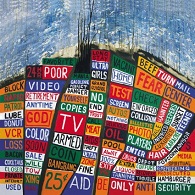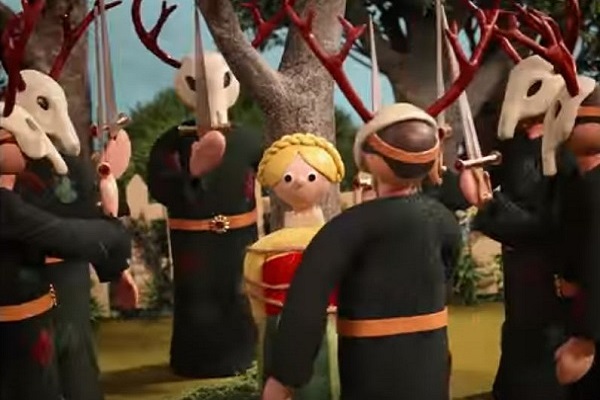
Watch Radiohead’s “Burn the Witch”: Witchcraft, Burning Man, and Groupthink
- By Alison Lesley --
- 03 May 2016 --

Radiohead’s return with “Burn the Witch” touches on witchcraft and the mob mentality.
Fans who have eagerly awaited the comeback of Radiohead are in a for a treat today: the band released the video of the first single of its upcoming ninth album, entitled Burn the Witch, which is set to be available via all digital services by tomorrow, May 4. The release was preceded by a mysterious erasure of the band’s social media presence over the past couple days, which in turn generated its own discussions on social media.
Watch Radiohead’s “Burn the Witch”: A Chilling Statement Against Mob Mentality[/tweetthis]

The response to the song’s release is a welcoming fascination, blazing through prominent online publications as the song has pierced through listeners’ consciousness. Music critic Neil McCormick of Telegraph UK called the upcoming 9th album “hugely promising,” dubbed it the return “[to the band’s] vintage nineties best,” and praised Thom Yorke’s vocals, writing that it “creates an affecting intimacy with the listener, gliding with beautiful melodiousness even as Yorke delivers with messages of cryptic fear and loathing.” Indeed, beyond the haunting melody, the flawless vocals and the cryptic, yet poignantly hard-hitting lyrics, those who have soaked up the songs’ subliminal message are more interested in the semantics of the song. Pitchfork senior editor Jillian Mapes states that “Burn the Witch has the makings of an all-time great Radiohead song,” relating it to the struggle against “groupthink,” while Courtney Lindley, entertainment writer for Bustle.com says that Radiohead may be warning us against “mob mentality” through the ominous song.
#Radiohead – Burn The Witch https://t.co/H1YNSVivsM Back with cold heart vengeance 😀
— kaoskongo (@kaoskongo) May 3, 2016
Perhaps the most intriguing analysis of the song are those that relate it to the 1973 mystery horror film, The Wicker Man. According to The Altantic’s Spencer Kornhaber, the Burn the Witch video “is a Claymation retelling of The Wicker Man.” Again, the political overtones of the song are not lost on Kornhaber: “Thom Yorke’s lyrics speak of the kind of mass action and complacency that allows such a crime and, the logic probably goes, many other cruelties committed by societies.”
A quick viewing of the video and a little digging into what the movie classic was all about tell us why The Wicker Man is believed to be a reference for the new song. The critically acclaimed movie begins with the story of Sergeant Howie, who goes to the island Summerisle to investigate the disappearance of Rowan Morrison, a young girl. Howie, being a devout Christian, finds the disturbing sight of the islanders worshipping pagan Celtic gods of their ancestors. They also participate in public sex, tell children of the phallic significance of the maypole and cure sore throats by placing toads in their mouths. Rowan’s mother claims that the young girl never existed, attempting to stop the investigation. As the plot moves along, Howie discovers that Rowan has been chosen as a human sacrifice after a poor harvest, to ensure more bounty in the next one. As the villagers are about the sacrifice the poor girl, he sets her free and takes her with him as he flees. The islanders stop them before they have a chance to escape, however, and Rowan gladly returns to her captors. Lord Summerisle reveals the sordid truth to Howie: he is the intended sacrifice, not Rowan. He is forcibly put into a giant wicker man statue, similar to the one we see in the Burn the Witch video, and it is set on fire. Howie mouths Psalm 23 and prays to Jesus Christ before burning to death.

Trumpton just turned all dark and Pagan with this Wicker Man inspired video. Radiohead – Burn The Witch https://t.co/uKc7ajc1Zn via @YouTube
— Tristian Doe (@tristiandoe) May 3, 2016
Do yourself a favor and listen to the new Radiohead single with your headphones on, otherwise you're missing out.https://t.co/tfCwonb1yV
— Georgie V (@LAboytoy) May 3, 2016
The Wicker Man was adapted from Ritual, a 1976 novel written by David Pinner. The large burning figure in the movie is now re-created in neo-Pagan festivals, but it is believed that the Wicker Mans in history is equally as harmless as the simulated ones today. It is said that the Romans utilized the legend of the Wicker Man to tarnish the reputation of Celtic paganism.
Burn the Witch is chilling as much as it is inspiring, a melodious commentary on the cacophony that ensues with the departure from reason that we practice as we burn the “witches” of our time. The jolting comparison of modern-day mob mentality to such pagan practices is a call-to-action and a wake-up call to our sleeping sensibilities.


















